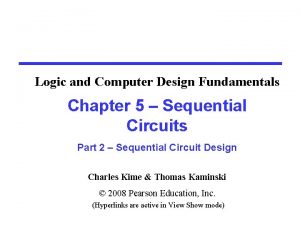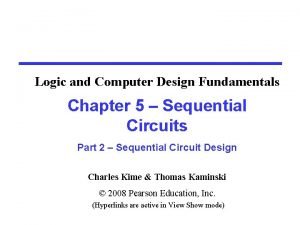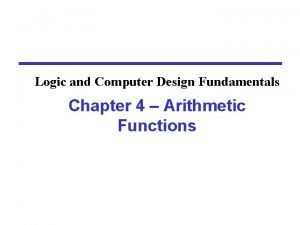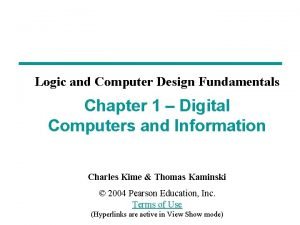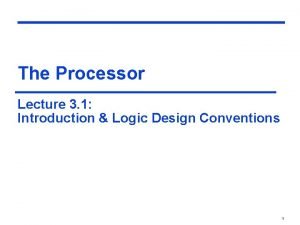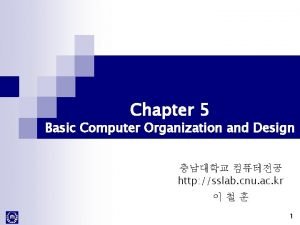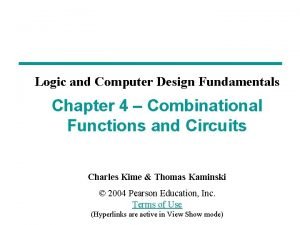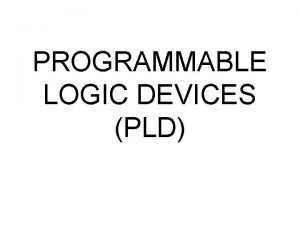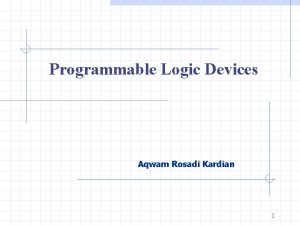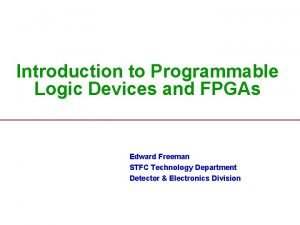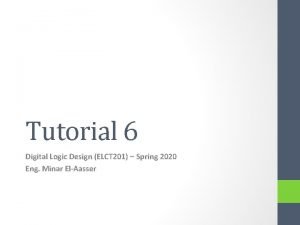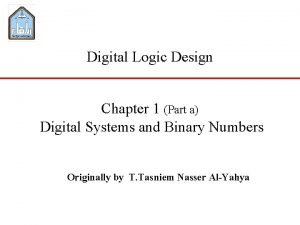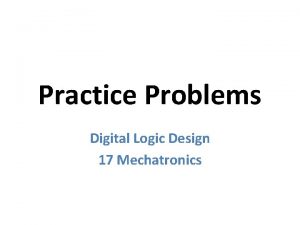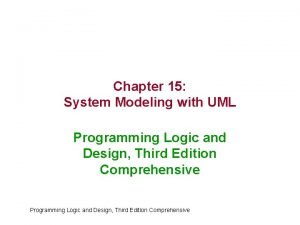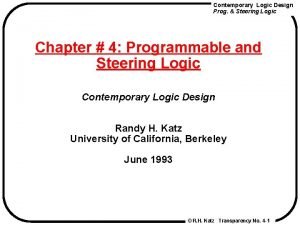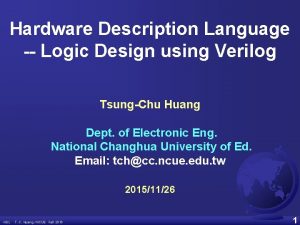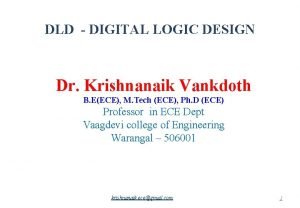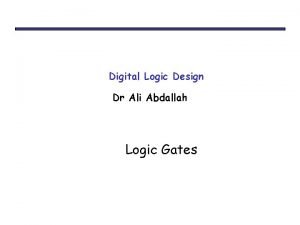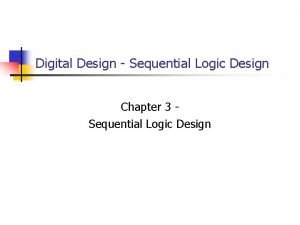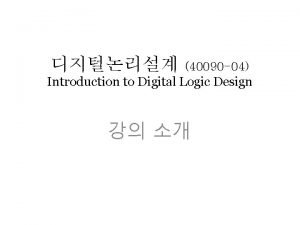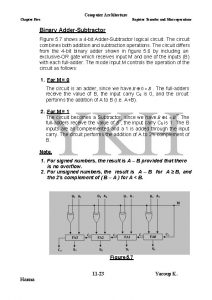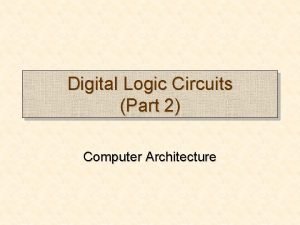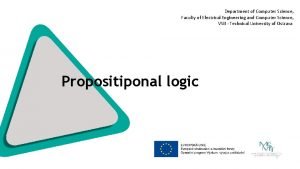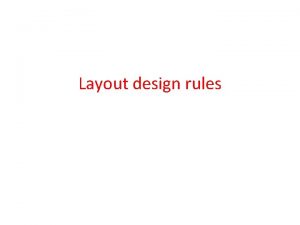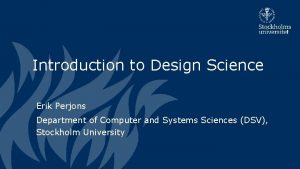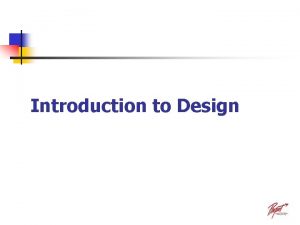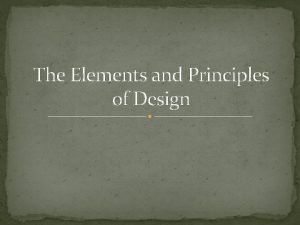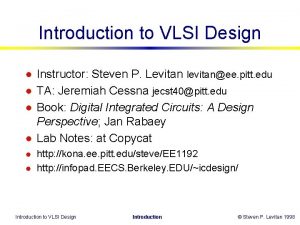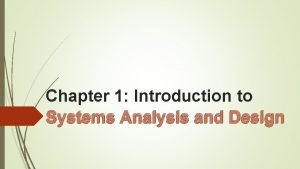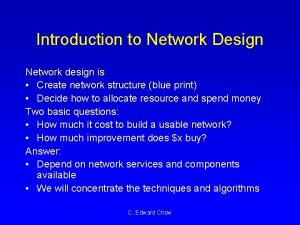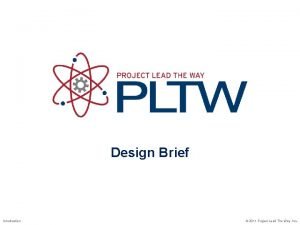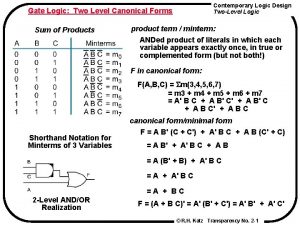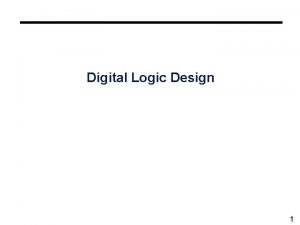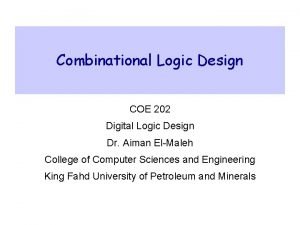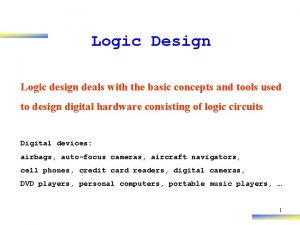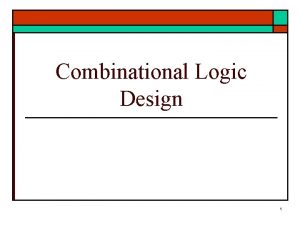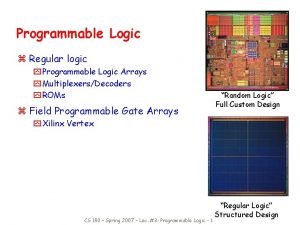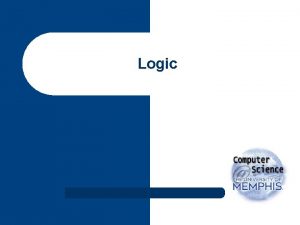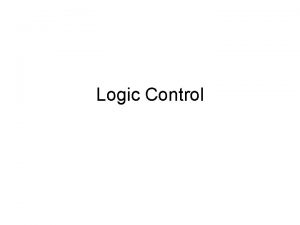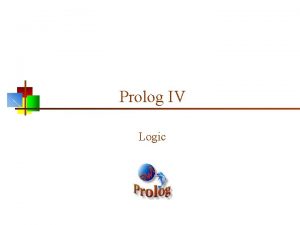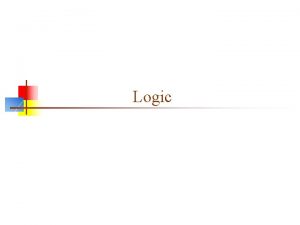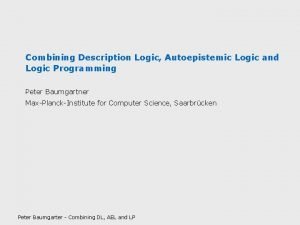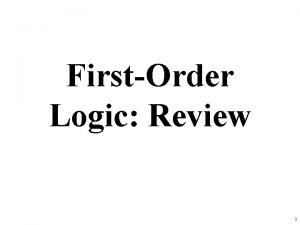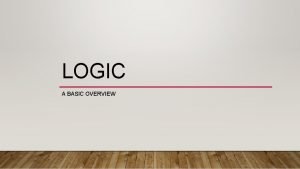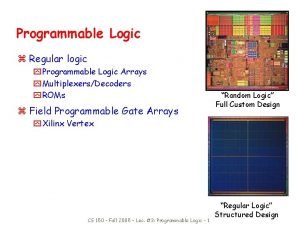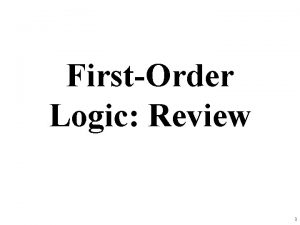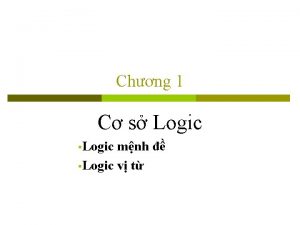Computer Logic Design Introduction 1 Computer What are

















































- Slides: 49

Computer Logic Design Introduction 1

Computer • What are there inside a computer? CPU FSB (Front-Side Bus) Main Memory (DDR 2) North Bridge DMI (Direct Media I/F) COMP 211 2 South Bridge

Computer • Computer is composed of many components CPU (Intel’s Core 2 Duo, AMD’s Opteron etc) Chipsets (North Bridge and South Bridge) Power Supply Peripheral devices such as Graphics card and Wireless card § Monitor § Keyboard/mouse § etc § § COMP 211 3

Bottom layer of a Computer • Each component is basically made based on analog and digital circuits § Analog • Continuous signal § Digital • Only knows 1 and 0 COMP 211 4

What you mean by 0 or 1 in Digital Circuit? • In fact, everything in this world is analog § For example, sound, light, electric signals are all analog since they are continuous in time • Digital circuit treats a signal above a certain level as “ 1” and a signal below a certain level as “ 0” § Power supply provides power to the computer system COMP 211 5

What you mean by 0 or 1 in Digital Circuit? § Power supply in your computer has several outlets § Different components may have different voltage requirements • CPU (Core 2 Duo): 1. 325 V • Chipsets: 1. 45 V • Peripheral devices: 3. 3 V, 1. 5 V Note: Voltage requirements change as the technology advances 1. 325 V “ 1” Not determined “ 0” 0 V COMP 211 time 6

Digital and Analog? Analog Digital music video wireless signal COMP 211 7

Structure & Function • Structure is the way in which components relate to each other • Function is the operation of individual components as part of the structure

Function • All computer functions are: § § Data processing Data storage Data movement Control

Functional view • Functional view of a computer Data Storage Facility Data Movement Apparatus Control Mechanism Data Processing Facility

Operations (1) • Data movement § e. g. keyboard to screen Data Storage Facility Data Movement Apparatus Control Mechanism Data Processing Facility

Operations (2) • Storage § e. g. Internet download to disk Data Storage Facility Data Movement Apparatus Control Mechanism Data Processing Facility

Operation (3) • Processing from/to storage § e. g. updating bank statement Data Storage Facility Data Movement Apparatus Control Mechanism Data Processing Facility

Operation (4) • Processing from storage to I/O § e. g. printing a bank statement Data Storage Facility Data Movement Apparatus Control Mechanism Data Processing Facility

Structure - Top Level Peripherals Computer Central Processing Unit Computer Systems Interconnection Input Output Communication lines Main Memory

Structure - The CPU Computer Arithmetic and Login Unit Registers I/O System Bus Memory CPU Internal CPU Interconnection Control Unit

Structure - The Control Unit CPU Sequencing Login ALU Internal Bus Registers Control Unit Registers and Decoders Control Memory

Computer Architecture is the design of computer , including their instruction sets, hardware components, and system organization. The computer architecture consists of two parts ; • Instruction set architecture (ISA( • Hardware system architecture (HAS (

• The instruction set architecture : ����������� Software/Hardware ��������������������� • The instruction set • The instruction formats • The available addressing techniques • The format of the available data types • The Operational register set and usage


Computational Models • Two primary computational models § Von Neumann Model § System Bus Model • The Von Neumann Model consists of five major subsystems (input, output, control, arithmetic, memory) • The System Bus Model streamlines this into three subsystems (CPU, memory, IO)

Von Neumann Model Memory Unit Data Path Input Unit Arithmetic and Logic Unit (ALU) Control Unit Control Path Output Unit

System Bus Model CPU (ALU, Registers, and Control) Memory Input and Output Data Bus Address Bus Control Bus

Computational Models • Consider the implications of these alternative designs § Design 1: Central processor with special cabling to specialized devices § Design 2: Multi-bus with common parsing of data and control packets for device-ids

Introduction to Computer Architecture • • History Computational Models >> Levels of the Machine Computer System Metaphor

Levels of the Machine • 1. Individual electrical components § Transistors § Resisters § Capacitors • 2. Circuit boards • 3. Specialized devices § Power supply § Cooling fan

Levels of the Machine • 4. Specialized components § Graphics accelerator § Memory banks • 5. Mother board § § § CPU Battery Plug-in expansion card slots Specialized components Connector for power supply

Levels of the Machine • • 6. 7. 8. 9. § § Operating system and device drivers Machine language Compilers and interpreters High-level languages Java C++ Visual Basic Microsoft Excel (? )

Levels of the Machine • • 10. 11. 12. 13. 14. 15. 16. Single-user applications Network components and software Multi-user centralized applications Internet connection devices and s/w Internet utilities (global / specific) Web connection devices and s/w Web utilities (global / general)

Introduction to Computer Architecture • • History Computational Models Levels of the Machine >> Computer System

Typical Computer System • • • Hard Disk Floppy Disk Tape Backup Random Access Memory Central Processing Unit Graphics Accelerator Card Keyboard Monitor Printer

Computer System The intent of the following slides is to remind us to ask, when studying any computer component, “What problem is this intended to solve? ”

Digital Computers • Computer Structure

Digital Computers • Basic Structure § memory unit: stores programs, input, output, data § processor unit: performs arithmetic and other data-processing operations, as specified by the program § control unit: supervises the flow of information between units (CPU = control unit + data path) § input device: key board § output device: CRT, LCD • More § FPU (floating-point unit) § MMU (memory management unit) (Memory: MMU + internal cache + external cache + RAM)

Classification of Computer Architectures

Von Neumann Machine ����������� John von nuemenn ����������� IAS ( Institute for Advanced Studies) ������� Princeton University in the 1940’s



The major subsystems within the CPU are: • The control unit (CU) • The arithmetic and logic unit (ALU) • A register set

Von Neumann Model • Input Unit Memory Unit Input Unit Arithemtic and Logical Unit (ALU) Control Unit § Provides instructions and data to system Output Unit

Von Neumann Model • Output Unit Memory Unit Input Unit Arithemtic and Logical Unit (ALU) Control Unit § Returns data from system Output Unit

Von Neumann Model • Memory Unit Input Unit Arithemtic and Logical Unit (ALU) Control Unit § Storage for instructions and data Output Unit

Von Neumann Model • ALU Memory Unit Input Unit Arithemtic and Logical Unit (ALU) Control Unit § Processes data Output Unit

Von Neumann Model • Control Unit Memory Unit Input Unit Arithemtic and Logical Unit (ALU) Control Unit § Directs processing Output Unit

Von Neumann Model • CPU Memory Unit CPU Input Unit Arithemtic and Logical Unit (ALU) Control Unit Output Unit § ALU and Control Unit combined

System Bus Model Memory Input & Output (I/O) System Bus CPU (ALU, Registers, & Control) Data Bus Address Bus Control Bus • Streamlined version of von Nuemann model § § Data Bus Address Bus Control Bus Power Bus (optional)

System Bus Model System Bus CPU (ALU, Registers, & Control) Memory Input & Output (I/O) Data Bus Address Bus Control Bus • Data Bus § Carries the information being transmitted § Sometimes implemented as data-in and data-out buses

System Bus Model Memory Input & Output (I/O) System Bus CPU (ALU, Registers, & Control) Data Bus Address Bus Control Bus • Address Bus § Identifies where the information is being sent § “Memory” address identifies read/write location

System Bus Model System Bus CPU (ALU, Registers, & Control) Memory Input & Output (I/O) Data Bus Address Bus Control Bus • Control Bus § Describes aspects of how the information is being sent, & in what manner
 Insidan region jh
Insidan region jh Logic and computer design fundamentals
Logic and computer design fundamentals Logic and computer design fundamentals
Logic and computer design fundamentals Logic and computer design fundamentals
Logic and computer design fundamentals Logic and computer design fundamentals
Logic and computer design fundamentals Logic design conventions
Logic design conventions Basic computer design
Basic computer design Logic & computer design fundamentals
Logic & computer design fundamentals First order logic vs propositional logic
First order logic vs propositional logic First order logic vs propositional logic
First order logic vs propositional logic First order logic vs propositional logic
First order logic vs propositional logic Combinational vs sequential logic
Combinational vs sequential logic Cryptarithmetic problem logic+logic=prolog
Cryptarithmetic problem logic+logic=prolog Software development wbs
Software development wbs Is it x y or y x
Is it x y or y x Combinational logic sequential logic 차이
Combinational logic sequential logic 차이 Logic chapter three
Logic chapter three What is pld
What is pld Fixed logic devices
Fixed logic devices Introduction to programmable logic devices
Introduction to programmable logic devices Disadvantages of pld
Disadvantages of pld What is basic computer organization
What is basic computer organization Digital logic design tutorial
Digital logic design tutorial Digital logic design number system
Digital logic design number system Digital logic design practice problems
Digital logic design practice problems Logic design uml
Logic design uml Digital logic design lectures
Digital logic design lectures Steering logic
Steering logic Logic design
Logic design Logic design
Logic design Logic design
Logic design Digital design
Digital design Logic design
Logic design Digital logic design
Digital logic design Logic microoperations in computer architecture
Logic microoperations in computer architecture Digital logic and computer architecture
Digital logic and computer architecture Computer logic
Computer logic Conclusion paragraph format
Conclusion paragraph format System analysis and design
System analysis and design Introduction to layout design
Introduction to layout design Introduction to interior design
Introduction to interior design An introduction to design science
An introduction to design science Introduction of design
Introduction of design Introduction to elements of design
Introduction to elements of design Introduction to vlsi design
Introduction to vlsi design Size in floral design
Size in floral design Introduction to system analysis and design
Introduction to system analysis and design Design and analysis of algorithms introduction
Design and analysis of algorithms introduction Introduction to network design
Introduction to network design Design brief example pltw
Design brief example pltw

